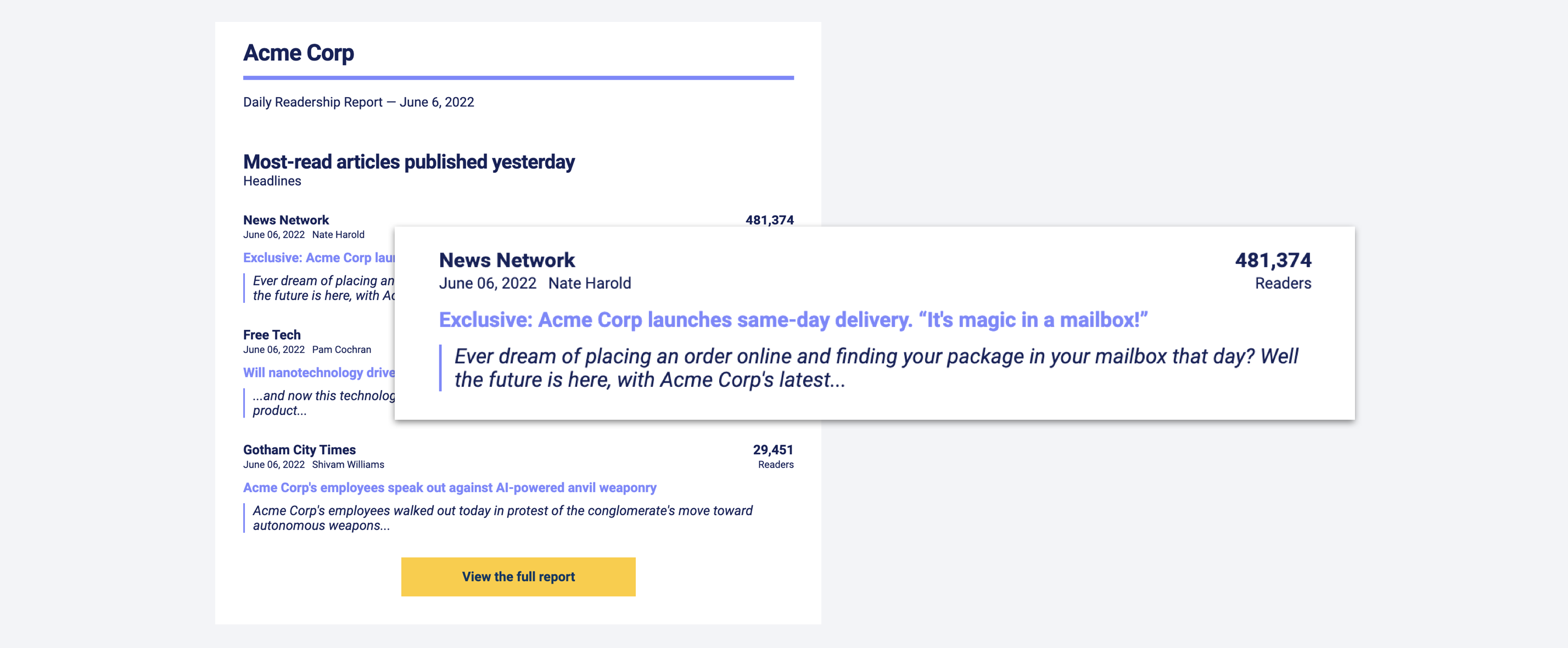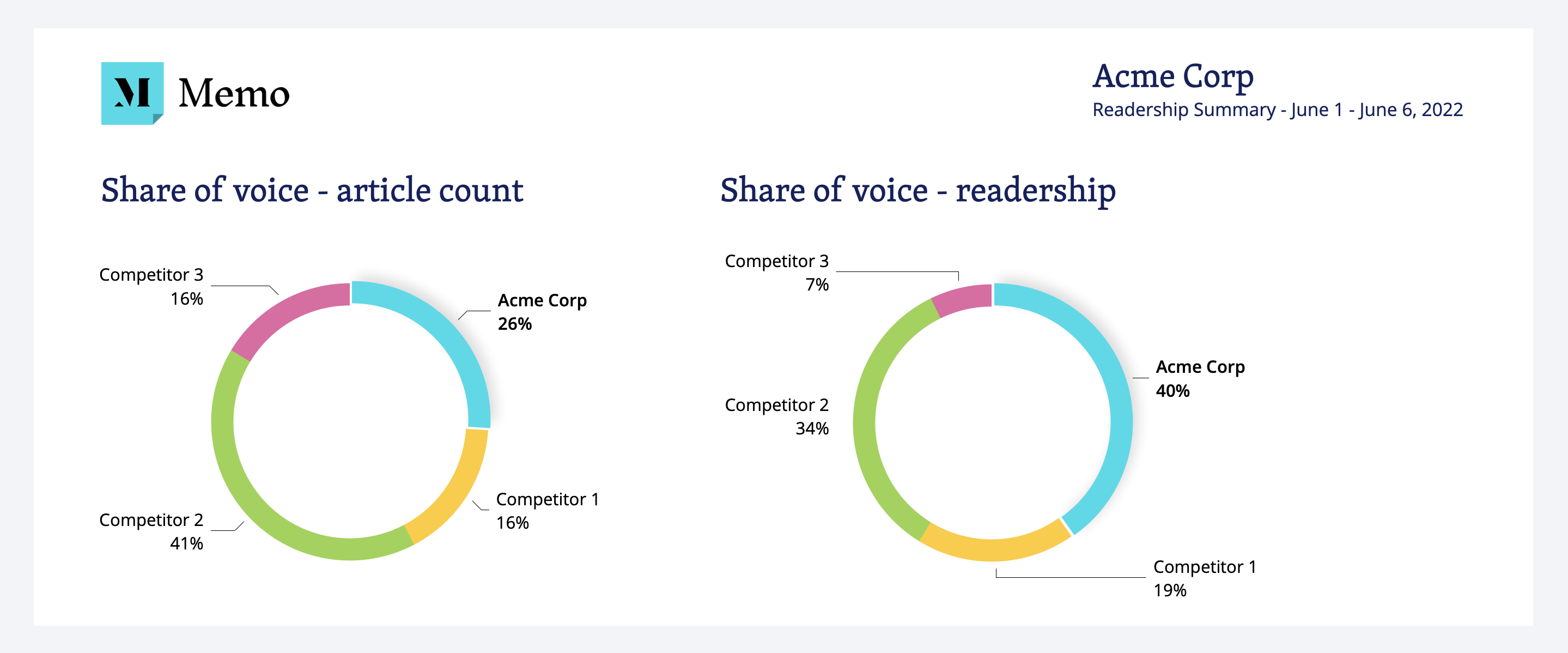July 11, 2022
How to roll out readership in your Comms org: 9 tactics from Memo customers
By Allison Horton
“Data like readership is for the Comms team of the future. A change not for the unambitious – and a challenge to the status quo that has eclipsed PR for decades.” –CCO, Fortune 500 company
How can I convince the data skeptics in our group to track readership? How do we send campaign reports with thousands of readers when executives are used to millions of impressions? How have other customers introduced this new metric?
You’re not alone. We’ve heard it all. From the most data-hungry communications teams to groups just getting their measurement practice off the ground, all Memo customers share the same challenge: adopting a metric of earned-media measurement for which there is no organizational precedent or historical context.
But change is the only constant in life, as the adage goes, and PR measurement is definitely changing. It would be disingenuous to pretend that widely adopting readership is as easy as flipping a switch; most of our customers are global corporations with a complex network of Comms groups and stakeholders to navigate.
Yet time and time again, we’ve seen our users grow from a core group of early adopters at a brand to an organization-wide audience. Here are 9 ways we’ve seen these customers successfully introduce and report out readership, often in combination with each other.
The takeaway: Rolling readership out incrementally, leading with insights, and reporting in a way that is aligned with but enhances existing practices is the best way to garner buy-in and adoption.
Introduce readership incrementally (#1-3)
Instead of overhauling their PR reporting from the outset, most teams find success rolling out readership incrementally. This means a select group of people have access to Memo’s platform, and they selectively loop in new team members through various reports. Over time, stakeholders get accustomed to seeing readership regularly and begin to proactively request readership in additional reporting.
Here are the Memo tools we’ve seen leveraged to slowly but steadily disseminate readership:
#1: Circulate top-read press via daily Readership Emails
These daily reports of the three top-read headline and non-headline mentions are an easy way to start distributing readership data throughout an organization. There’s no limit on the number of recipients, and we’ve seen these emails balloon from a group of four people in a measurement team to dozens of Comms employees, all the way up to the CCO.

#2: Isolate readership with campaign-specific Flash Reports
Many customers use Flash Reports, which are on-demand readership summaries of specific campaigns or news cycles, as a stepping stone to reporting out readership more broadly.
Flash Reports answer questions that are top-of-mind for a team running a campaign – e.g. How many people did we reach? Which outlets had the biggest impact? How did interest in this news cycle play out over time? – without making them sift through data on coverage that’s not relevant to them.
#3: Dazzle executives with MRV summaries
To combat the common fear that “trading millions of impressions for thousands of readers” will make communicators look worse (it won’t, we promise!), presenting MRV (Memo Readership Value) alongside readership to executives is a great entry point to reframing the value of a reader.
We write more about MRV here, but in brief, it’s a methodology to assign a dollar value to earned readership using paid-media rates in a way made possible with accurate article readership and traffic source data.

Lead with insights (#4-6)
Many customers generate buy-in for readership by showing how easily it lifts the veil on long-held questions and takes the guesswork out of campaign planning. Leading with insights over metrics will help connect the dots between readership and how it can be actioned. Here are some ways to surface these insights:
#4: Report aggregate readership at the outlet level
Definitively answering which outlets and reporters perform best for your campaigns is nothing short of a superpower – and fortunately this intel is readily available in your Memo dashboard.
Next time you’re tasked with providing strategic guidance on media outreach, filter your coverage for topics related to that campaign and you’ll have a clear view into the most impactful sources:

#5: Share findings and takeaways from Insights Reports
Insights Reports are custom analyses designed to answer key questions on earned-media performance and strategy, and readership has taken these insights to a whole new level (see 10 PR strategy questions finally answered with Insights Reports).
We’ve witnessed multiple customers get Comms groups hooked on readership by introducing it through insights reporting. Typically, our primary contacts monitor for opportune moments to support analyses and planning with readership. They’ll tell their Memo rep the questions they’re hoping to answer with readership, and our Insights team gets to work.
#6: Introduce readership within a Reporter Database
Memo’s Reporter Database isn’t just a list of names with the coverage they’ve authored; it’s an entirely new way of helping Media Relations teams prioritize relationship building and outreach. It includes readership on reporters’ articles, tags for frequently covered topics, and summary stats for easy comparison.

Enhance existing reporting (#7-9)
Finally, customers often treat readership as additive in the early days, using it to enhance existing measurement while they allow time to understand the best way to phase out legacy practices.
#7: Report readership alongside other metrics
One large corporation was not ready to eliminate UVMs from their global reporting, but still wanted to include readership in campaign summaries. So in a global campaign recap, they reported their usual metrics – clip counts, UVMs, social engagement – and introduced a new metric: “verified readers from our new partner, Memo.”
#8: Report relative performance instead of absolute values
For groups that are anchored on massive impression numbers, it can take time to make readership palatable, especially if those audiences aren’t privy to the insights and context of longtime Memo users. Ways we’ve seen customers report out readership results without readership itself include:
% of your brand’s readership driven by a specific article/publication/topic (e.g. "this placement is responsible for 58% of our announcement's readership")
An article’s readership percentile (e.g. “this placement’s performance is in the 90th percentile for our historical coverage”)
The % of readership your brand received on an outlet relative to competitors (e.g. "Acme Corp had over 2x more readership on Fortune last month than competitors")
#9: Add “share of readership” to SOV reports
Related to the above, monitoring share of readership amongst competitors, especially when contrasted with share of coverage volume, reveals who is generating meaningful engagement with their press – and is a powerful way to demonstrate why readership provides a more accurate view of media performance.

There’s no silver bullet to transforming a measurement practice overnight, but Memo provides multiple tools (and some wonderful customer success reps) to help you steadily introduce readership and prove the value of more accurate measurement.